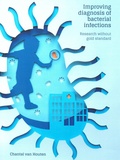Improving diagnosis of bacterial infections
Research without gold standard
Summary
Timely antibiotic treatment improves the outcome of patients with bacterial infections, but antibiotics are not indicated in case of viral infections. Unfortunately, it is often not possible to differentiate between bacterial and viral infections based on clinical judgement alone, even when using available blood tests. Different aspects of this diagnostic dilemma were studied in this thesis.
First, we evaluated the consequences of this complicated diagnostic process on antibiotic use. We used an expert panel of physicians to assign a viral or bacterial diagnosis to each individual case. We found that one third of all children infected with the respiratory syncytial virus (RSV) and without presumed bacterial co-infections were treated unnecessarily with antibiotics. When studying children and adults with respiratory tract infections (RTI), we found that the proportion of viral infections was larger in children than in adults (74% versus 38%). However, antibiotic overuse was less frequent among children with viral RTI than adults with viral RTI (37% versus 83%). These findings support the need for effective diagnostics in RTI patients of all ages.
Second, we validated a novel diagnostic to differentiate between viral and bacterial infections. Therefore, we performed a double-blinded, prospective, international study (the OPPORTUNITY study) in children below the age of five. We studied a novel assay combining three proteins: tumour necrosis factor-related apoptosis-inducing ligand (TRAIL), interferon gamma induced protein-10 (IP-10), and C-reactive protein (CRP). We showed that this combination of biomarkers upregulated by viral and bacterial infections had a high diagnostic value. The assay is especially helpful for ruling out bacterial infections. The number of false positives decreased with 51% if the combination assay was used instead of CRP alone. This result suggests that this assay has the potential to reduce antibiotic misuse in young children.
In addition to biomarkers, clinical signs and symptoms play an important role when physicians diagnose febrile children. We therefore integrated the above-mentioned combination assay in an existing clinical prediction model for febrile children. This model includes clinical parameters and CRP and was updated with the combination assay. The updated model was more accurate in predicting serious bacterial infections compared to the model with CRP as the only biomarker.
Third, the absence of a gold standard to diagnose bacterial infections is troublesome in diagnostic studies. In this thesis an expert panel reference standard was used to establish patient outcomes (i.e. bacterial or viral infection). We evaluated the reproducibility of such an expert panel diagnosis. We found that a three-expert panel provides more reproducible diagnosis than an individual expert. Even with a time interval of three years, the intra-panel agreement was high. Increasing the size of the expert panel to seven experts has no major advantage.
In this thesis we showed that antibiotic overuse is a large problem in children and adults. A new diagnostic test can help physicians to differentiate between bacterial and viral infections and can decrease antibiotic overuse in young children. Our findings support the need for implementation research to examine the utility of this assay.
